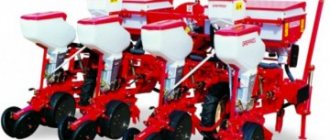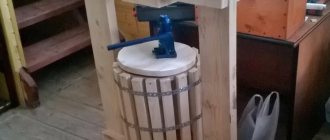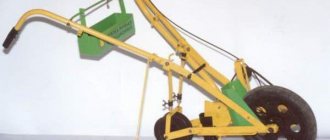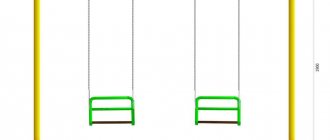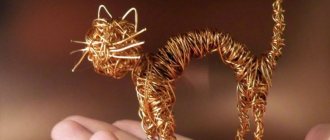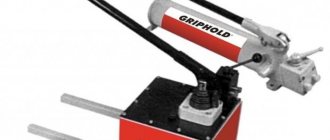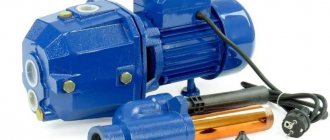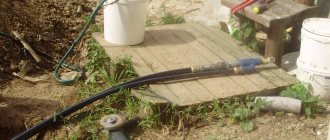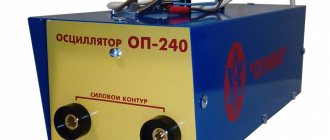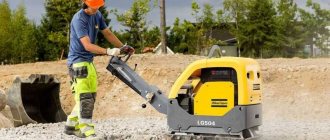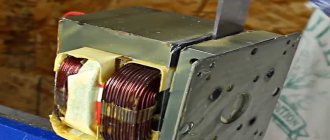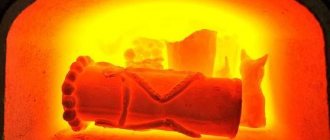Homemade products from a washing machine engine:
1. How to connect a motor from an old washing machine through a capacitor or without it 2. Homemade emery from a washing machine engine 3. Homemade generator from a washing machine engine 4. Connecting and adjusting the speed of a commutator motor from an automatic washing machine 5. Potter's wheel from a washing machine machines 6. Lathe from an automatic washing machine 7. Wood splitter with an engine from a washing machine 8. Homemade concrete mixer
Homemade seeders and planters with your own hands (video selection)
1. DIY seeder
We show in detail a device for planting radishes and granulated carrots.
2. Two devices for planting radishes. Seeder "Spider"
3. Do-it-yourself manual seeder with metering sleeve
Unlike the previous version of the homemade seeder, a bushing with metering seeding and a larger loading hopper for seeds are used here.
Seeds of normal size, that is, large seeds, are captured by the sleeve into the seed holes when rotated. The dose in this case corresponds to the seeding rate.
The outer edges of the seed sleeve were processed to one level and blind holes for the seeds were drilled every 90 degrees along the outside. The depth and diameter of the holes must correspond to the level of its filling with a certain amount of seeds corresponding to the type of crop.
For example: corn is filled with two or three seeds, beans with one seed, peas with one or two. The number of seed holes depends on the seed crop. That is, the density of crop seeding in a row depends on the number of blind holes on the outside of the bushing. Together with the seed hopper, the seeding unit is attached to the frame of the garden unit with three racks and the unit operates as a manual seeder.
The device on the unit is located in such a way that the seeds from the sowing device fall into the opener without getting stuck in the seed tube. Convenient visibility of the coulter and discs during sowing.
4. Homemade do-it-yourself precision seeding seeder
5. Homemade planter and digger
The planter's productivity is 20 acres in 1 hour. Digger productivity is 10 rows in 1 hour.
6. Manual potato planter
This is the potato planter my neighbor made. And I was the first to try planting potatoes with it. The impressions are positive: there is no load on the back, plus the landing speed has increased. What I planted last year in two days with a pitchfork, this year I planted in 3 and a half hours. And no calluses or torn back.
The only condition is that the ground be soft, for example after processing with a walk-behind tractor))) On short rows, that’s what you need.
7. Homemade seeder for walk-behind tractor
The sowing wheel is made of plastic water pipe, thick-walled pipe, outer diameter - 40mm, wall thickness - 7mm. I have several reels, with specific holes for different seeds. Holes (recesses) should in no case be through. For alfalfa - 2-2.5 mm deep, and for grains, almost the entire thickness. Wall thickness 7mm. It would be ideal to replace this pipe with a whole round timber. As an option, you can glue a pipe of smaller diameter inside the pipe.
Source: eurosamodelki.ru
Homemade manual seeder: nuances of accurate and simple sowing
Every summer resident and gardener knows how important it is to plant vegetables correctly. This process is labor-intensive, quite expensive in both time and money. After all, it is necessary not only to evenly distribute the planting seeds in the furrows, but also to further thin out the seedlings manually, forming crops. A special seeder will help to significantly simplify the work, which, even in manual mode, will be a real help in planting. The article will discuss the nuances of the operation of planting structures, the principle of manual assembly of the simplest mechanisms, the features of operation and the creation of manual machines for more accurate seeding.
Why do you need to use mechanization?
The amount of harvest obtained per unit area of land depends on the timeliness of agricultural work. To ensure healthy plant growth, all operations must be carried out at optimal times. The quality of seed work is of great importance. Nowadays, manual labor is still used. This is a very labor-intensive process that requires a lot of time and the involvement of additional workers, which affects the profitability of the enterprise.
Manual work also makes accurate sowing difficult. Further care of plants becomes more complicated. The way out of this situation is to use small-scale mechanization machines, the category of which includes a manual vegetable precision seeder. It guarantees high-quality and timely planting of small-seeded vegetable crops. This is a very useful model, the peculiarity of which is the economical consumption of seed material.
The precision seed drill is used for sowing work and field experiments on farms and private farms.
Tool requirements
A completely working structure is made from available materials: various recyclable materials, tin cans, plastic bottles. It is advisable to use more complex structures made of metal sheets only for industrial-scale cultivation of vegetable crops.
A good example of the simplest design for planting is a carrot seeder.
Certain aspects apply to self-made mechanisms for planting vegetables.:
- The placement of seed into the soil must be in a certain quantity (per 1 linear meter) and to the required depth.
- Seeds should be distributed evenly, without gaps and without damage.
- The mechanism ensures straightness of planting rows and row spacing.
- After each laying, the grooves should be filled with loose soil.
Sowing small seeds is best done using mini-seeders. Such devices are suitable for growing carrots, onion sets, salad greens, that is, those crops that have rather small planting material.
Features of application
The basic principle of operation of the simplest sowing mechanism is to limit the spilling of seeds out. An open box with a double good bottom is used for this procedure. A movable plate is inserted into the formed space.
Grains or seeds are poured into the bottom of the box (upper) with holes slightly larger than the size of the planting material; in the lower tier of the mechanism there are larger holes, they coincide with the top. When pushing in the middle intermediate plate, the holes in the bottoms do not communicate, which means the grains do not spill out. If the valve is moved, the sower will start working again. To avoid thickening of the crops, you should not pour a large number of seeds into the structure at once, rolling them over the mechanism.
Many vegetable growers equip the movable (middle) plate with a spring, which facilitates the operational process.
DIY making
By using a mechanism for planting small seeds, sowing can be accelerated 10 times. As an example of a simple hand-held device, consider a carrot seeder.
To make it you will need the following materials::
- Plastic or metal shaft. You can use a part from a thick-walled pipe.
- A wheel made from a tin can (a small bicycle wheel will do).
- A bunker made from a plastic bottle, container, or shampoo container.
- Retaining rings designed for the wheel.
- Foam rubber.
- Transport bracket (1 piece).
- Wooden handle.
- Screw “M 4” (from 4 to 8 pcs.).
- Restrictive rings/clamps (from 2 to 4 pcs.).
- Nut “M 4” (from 4 to 8 pcs.).
For high-quality assembly you will need tools: a screwdriver, drills with different diameters, scissors, a drill, a knife.
The process of manufacturing a simple manual seeder takes place in several stages:
- The shaft is being prepared. In the middle of the plastic pipe, recesses of different diameters are drilled (for large and small seeds). The pipe is not drilled through.
- Wheels are made from tin cans. To ensure better grip, rubber rings are placed on the wheels in several rows. In the middle, using scissors, a hole is cut equal to the diameter of the shaft.
- A hopper is cut out of a plastic container. The lower part is cut off, holes are made on the opposite walls for the sowing shaft. The bottle is placed upside down.
- The hopper is placed on the shaft. Foam rubber is laid and glued to the bottle walls so that during further rotation the excess seeds are removed. That is, when the foam brush is turned, the shaft should produce small cells, each of which will contain one or two seeds.
- The transport bracket is attached to the shaft with wheels and secured with screws.
- The hopper is carefully attached through a metal plate to the bracket. When the shaft rotates, it should not move.
- A wooden handle is installed.
The simple design will significantly reduce labor costs . This is how you make a manual seeder with your own hands. The main disadvantage of this mechanism is the limited sowing (only in 1 row) and the sowing of only one vegetable crop due to the different size of the seeds. The problem can be solved by using several replacement cans with different holes.
Much more complicated is a self-made sowing device, with which you can work with seeds of different crops. The main working mechanism in the universal design is the sowing shaft, which is an aluminum tube with a diameter of 30 mm. Holes are drilled in three rows of different sizes. Each line is made for one crop.
We made our own home seeder.
Our homemade manual seeder makes us happy for another year, although we have technically changed it for the better. It is convenient to use and easy to manage, and one filling of the seed hopper with corn seeds is enough for almost 60 acres.
The cover of the seed hopper of the seeder was made from a sieve for agricultural grain cleaning machines (type OVS, Petcus), through which the volume of remaining seeds in the hopper is clearly visible.
Tests of the seeding unit were carried out until the optimal location of the limiting petals was determined and the material for their manufacture was selected.
Restrictive petals in the seeder of the seeder serve to prevent spontaneous shedding of seeds into the seed tube and limit their number when dosing with a seed sleeve, that is, to let through those seeds that are in the hole of the seed sleeve-doser of the seeder.
One, the front limiter is cut out of thick elastic rubber and rests on one side against a metal limiter. It works on the principle of a throttle valve: it sweeps away all the seeds from the bushing except those in the holes and prevents the seeds from falling out of the hopper.
The rear petal is much wider than the front one and it prevents the seeds from falling from the hopper through the seed holes at the moment they appear in the dispenser window, that is, when the seed sleeve in operating mode brings the seed hole to the dispenser window.
There is a space between the seeder housing and the seed metering hub into which uncalibrated or small seed, sand and other particles can get in. In this case, the operation of the seeder will be difficult due to increased friction between the bushing and the walls of the seeder housing when using the seeder. The wear of parts increases, and abrasive corrosion of the rotating mechanism appears. What did we do?
The inside of the sides of the sowing unit body was glued with pieces of old velor using PVA glue. Velor fills the space between the seed sleeve and the walls of the apparatus; the textolite sleeve easily slides along the velor pile and can easily be rotated by hand when the seed hopper is fully loaded.
The seeding unit of the seeder has an opening hatch, which is suspended on a hinge made from a piece of an old welding electrode, welded to the top of the hatch. The hatch is fixed in the closed state with a clamping nut screwed onto a pin welded to the bottom of the device body.
Precision seeding mechanism
An important task of using seeding structures is to ensure uniform planting . To plant seeds in the ground at a strictly defined distance, manual precision seeding drills are used; these mechanisms are easy to make with your own hands, just like the simplest devices described above.
Design
The device consists of one or more containers with seeds, a frame on wheels, and a control handle. To independently manufacture such a unit, you will need a turning tool or a drill to drill metal sheets, the thickness of which is approximately 1 or 2 mm, and the diameter is about 5-8 mm.
When planning a connection between a seeder and a walk-behind tractor, it is better to use rigid bolts that are more vibration-resistant instead of rivets . The front wheels are designed to form furrows in the beds, where the seeds fall from the hopper. Using the rear wheels, the resulting holes are filled with loose soil.
The basis of the precision seeding design consists of a rectangular metal frame. Containers are attached along the edges into which seeds are loaded. It is recommended to buy the blocks necessary for turning the shaft separately, since it is very difficult to make them yourself without special skills and tools. For example, containers that are used in conventional manual seeders or in conjunction with walk-behind tractors are perfect.
The precision seed drill is driven by reversible wheels, which also adjust the height of the head, designed to get the seeds into the ground . Each container must be secured separately. The wheels are connected on a springy and rigid base.
The sowing unit is a container in which the seeds are placed. When the seeder is dragged along the ground, a mechanical wheel with blades, also located in the container, is activated. At the end of the container there is a narrow slot where only one unit of planting material can be placed, so seeding is uniform and very economical. The size of the hole can be changed to accommodate seeds of different sizes.
Operating principle
When working with a manual precision seeder, first do the assembly, move the handle to the working position, and put the rear wheel on the axle. The marker can be adjusted if necessary. Depending on the crop being sown, a disc of a certain size is installed in the hopper. The depth of the chalk is adjusted to the size of the seeds.
Design
The design of the precision seeder is very simple:
- It consists of a solid body mounted on a wheeled platform.
- For ease of control, the mechanism is supplemented with holders.
- The hopper is equipped with a lid that prevents seeds from spilling out or being blown away by the wind. It is made in a certain shape, so there are no dead zones in the corners of the hopper where seeds accumulate.
- The dosing shaft can be with one or two rows. The special design provides better grip, movement of seeds under the brush and clearer discharge. The shaft, which acts as a dispenser, rotates freely, ensuring sowing of seeds for any vegetable crops.
- The width of the row is set with special markers.
- The trapezoidal coulter, located at the base of the seeder, cuts a furrow and facilitates the shedding of soil into it after seed placement. Additionally, fertilizers can be applied. Thanks to the special shape of the coulter, lumps of soil do not get into it, and this in turn prevents jamming.
- The whiskers ensure free release of seeds along the step of the dosing shaft.
- A special seal helps reduce the germination time of seeds.
If necessary, seeders are connected into multi-row blocks for mechanized sowing using small wheeled tractors.
This is done using connecting strips. This method of joining is also advisable if it is necessary to organize work together.
Range of modern seeders
If making a planting unit yourself causes difficulties, it is recommended to immediately purchase ready-made structures. The assortment on the market is quite large. The American model of precision seeding “1001 - B” is equipped with 6 replaceable discs. With such a seeder you can plant 28 types of vegetable crops. Using the adjusting screw, you can change the planting depth.
Newtechagro seeders are single-row types. Designed for sowing beets, carrots, onions, and cabbage . But such designs are expensive.
But there are also cheaper analogues - precision seeders "SOR - 1/1". They are also single-row, can be equipped with a bush or brush sowing unit, the row marker is 0.5 m. This is quite enough for an average garden.
Using a manual seeder can significantly reduce labor costs, increases the speed of the planting process, simplifies the technology, significantly improves the quality of crops, and hence excellent harvests in the future.
Source: tokar.guru
For which crops is a manual precision seeding seeder used?
The spot seeder is suitable for a huge range of garden crops. Thanks to removable elements, it can quickly be adjusted to a specific hole size corresponding to the size of the seed material. The unit allows you to adjust the row spacing (up to 50 cm) and planting depth (1-15 cm).
These technical devices are used for:
- corn;
- beets;
- sunflower;
- Luke;
- carrots;
- spinach;
- asparagus;
- salad;
- beans;
- peas;
- lentils;
- rice;
- tomatoes;
- cucumbers;
- zucchini;
- watermelons;
- pumpkins;
- melons;
- squash;
- radish;
- turnips;
- soy;
- fennel.
The transition to sowing a new type of seed takes a few seconds. The burial depth is adjusted using an adjusting screw. Additionally, the unit can be equipped with a hopper for fertilizer, which is applied directly at the time of sowing the seeds.
A manual precision seed drill will make your work easier, save time and pay for itself within several seasons!
What is a corn planter?
A planter is a mechanism used to sow seeds into the soil. Before they were invented, sowing was done by hand, the grains were scattered as horizontally and evenly as possible. The advantage of mechanical seeders is more precise planting of seeds in depth and distance from each other, which undoubtedly increases the yield and makes the harrowing procedure subsequent after sowing unnecessary.
The principle of operation of the planter is that it feeds seeds into the sowing apparatus, which places them at the required depth and at the required interval, after which the sowing is completed by a specially designed planting mechanism. When using the planter on unprepared soil or over mulch, discs are installed directly in front of the opener, which cut the residue from the previous harvest and make landing slots to lighten the load on the skid opener.
A corn planter can be of different types and designs, this is due to the characteristics of its use, mainly the size of the plot or farm where the corn is sown. The following is a discussion of the types of planters.
Seeder SUPN-8
It has a universal purpose, that is, it can be used for sowing not only corn, but also other grains. It is equipped with a dotted pneumatic hinged structure, which makes it possible to sow seeds in rows at a distance of 50–60 cm. Together with the introduction of grains into the soil, it is capable of fertilizing crops. SUPN-8 is equipped with 8 sowing sections located on suspensions, as well as 4 fertilizer sowing sections designed for applying fertilizers.
Seeder for walk-behind tractor
The walk-behind tractor is a self-propelled device with one axle, essentially a type of mini-tractor, inferior to the latter in size and power. In the case of a walk-behind tractor, the seeder is an additional unit in the form of a hinged element, necessarily equipped with a grain calibrator for the possibility of its universal use.
The depth of grain placement in this type of seeder ranges from 1 to 5 cm, the distance between rows is from 15 to 30 cm, with the possibility of simultaneous processing of 2 to 4 rows. A corn planter for a walk-behind tractor can be either factory-made or home-made.
Seeder for mini tractor
As already mentioned, a seeder for a mini-tractor is an enlarged copy of a planter for a walk-behind tractor. It is also equipped with a seed calibrator; with the help of appropriate adjustments in accordance with the instructions, it can be configured for sowing corn. Unlike a walk-behind seeder, it is applicable for a larger sowing area, allows you to sow grains to a slightly greater depth (up to 8 cm) and has a wider range of row spacing - up to 70 cm.
Types of seeders and their design
Types of equipment differ in size, design and sowing methods. If large seeders are suitable for large farms, then in the garden a attachment for a walk-behind tractor is sufficient.
Trailed/mounted
According to the method of attachment to the equipment, trailed and mounted seeders are divided. The former require less productive machines to operate. For example, a tractor with a power of 45–60 hp. With. or seeding devices Kinze 3000, MT-8, YP-1630F, which have a power of 80 hp. With. They are aggregated with an eight-row YP-825 130 liter seeder. With.
Attachments are used to work with productive machines of at least the second class and tractors with high power (250–320 hp and 200–220 hp).
Mechanical/pneumatic
Corn sowing occurs in a dotted manner. In this case, seeders have a pneumatic or mechanical mechanism.
Mechanical seeders are gradually becoming obsolete and disappearing into oblivion; in many countries they have already been discontinued. To change the types of seeds, you have to completely dismantle the working panel and adjust the row spacing in a new way. There is simply not enough time for such a procedure.
Pneumatic corn seeders have a more advanced design, which includes:
- lump remover;
- furrow filler;
- compaction wheel;
- wedge tip;
- skid opener.
Her labor productivity is much higher with minimal time investment. Fertilizers are added along with the seeds. Among the significant disadvantages are:
- high price of the seeder;
- insufficiently effective work on problematic grounds;
- impossibility of use in fields where there are a lot of roots in the ground.
Manual/for walk-behind tractor/for special equipment
Manual devices are one of the most popular for sowing corn in small areas. Used in medium and small farms. They are characterized by high productivity: 0.5 hectares are sown in one day, provided that the land is prepared. They operate using a seed disc or plate at the bottom of the seed tank.
Seeders for walk-behind tractors allow seeding to be done in even steps in each row. To use them, holes are made in advance at a selected distance. Use devices only on loose and soft soils. Do not use on clay and heavy soil. The simple design is too heavy and bulky.
Seeders for special equipment are multifunctional. With their help, several types of corn are sown at once, simultaneously covering the maximum number of rows, the seeds are distributed over the marked holes, they are fertilized and covered with soil. This equipment has large dimensions and weight; it is used only on tractors and other machines with a power of 45 to 320 hp. With.
Rules and criteria for choosing a finished model
When choosing a particular type of seeder and its model, in addition to the area of the area to be sown, it is necessary to take into account such parameters as the accuracy of sowing in width and depth, with the ability to control these indicators, as well as the simplicity of the design, the reliability of the unit and its components. Of course, the versatility of the model and the possibility of simultaneous application of fertilizers to the soil play an important role. Finally, the price of the device plays a role. By comparing all these criteria and the importance of each of them in each specific case, you can choose the best option.
How to make a corn seeder with your own hands?
An alternative to buying a corn planter is to make a homemade planter. Here, in terms of materials and manufacturing methods, folk imagination is wide. Let's consider several options for making a seeder.
Materials and tools for work
To implement homemade production you need:
- plastic transparent container for grains in the shape of a jar;
- a bolt on which the seed tank rotates while the seeder moves;
- plastic pipe, comparable in length to the width of the seed container;
- a metal pipe of slightly smaller diameter than a plastic one;
- two washers for fixing the tank;
- a lid from a tin can, here it will serve as a lid for a jar of seeds;
- aluminum wire;
- wooden handle;
- hoe.
Step-by-step manufacturing instructions
Manufacturing instructions:
- Accurately measure the center of the seed container and drill a through hole.
- The lid of the tin can will serve as a valve to prevent the seeds from spilling out. To do this, the lid is cut out slightly larger than the hole for filling the seeds; it should be secured with aluminum wire so that the lid opens and closes freely during rotation.
- Place a plastic tube in the center of the can to prevent the can from compressing when the bolt is tightened.
- Insert a metal tube inside the plastic tube to form a bearing.
- Insert a bolt and nut into the metal tube and tighten with two washers.
- Using a hot nail, make two holes in the side of the grain container. The hole size should be equal to the size of the corn kernels.
- Using a wooden handle will make the seeder more convenient to use.
- The hoe will cover the sown seeds with soil. It must be bent and attached to the handle.
There is also a second option for making a planter of a more complex design, applicable both for sowing manually and using a walk-behind tractor.
The materials for its manufacture are more durable:
- steel sheets 2.5 mm thick for making a frame measuring 85x78 mm;
- vomer;
- as a reservoir for seeds - a galvanized steel box;
- an organic glass lid for covering the seed container, a furniture hinge and a latch;
- as a shaft for sowing - an aluminum tube with a diameter of 28 mm;
- M5 bolts, M6 screws;
- brush;
- two wheels.
Manufacturing instructions:
- Drill 3 rows of holes of different diameters in the sowing shaft, corresponding to the caliber of the seeds.
- Configure the frame according to the dimensions of the seed tank.
- At the bottom of the sides, drill holes with a diameter of 28.05 mm into which to insert the sowing shaft.
- Secure the grain box to the frame with bolts, and the brush, which regulates the sowing density by its vertical vibrations relative to the shaft, under the tank with screws.
- It is necessary to give the desired configuration to the truncated trapezoid of the seed container and the shaft holes.
- Attach the lid to the top of the tank using a furniture hinge and equip it with a latch.
Video: how to make a corn seeder with your own hands
When sowing manually without a walk-behind tractor, you must also independently make furrows for sowing grains. However, even when working with a manual seeder, the gardener’s energy is significantly saved, labor productivity and the quality of sowing are increased, and a homemade corn seeder will save money on the purchase of a factory unit.
Source: farmer.blog
DIY seeder for walk-behind tractor
A grain seeder for a walk-behind tractor belongs to the category of agricultural machines used to evenly plant seeds into the soil. Before the invention of the seeder, crop seeds were scattered manually, as a result of which the required seeding density was not achieved.
In addition, planting seeds by hand requires a lot of physical effort. Economically, manual sowing is not justified: scattered seeds fall unevenly onto the soil, and much more is wasted than when using a seeder. Also, manual planting leads to uneven distribution of seeds, as a result of which the soil is quickly depleted.
DIY seeder for walk-behind tractor
Nowadays, seeders occupy a worthy place among the equipment used by farmers. Using seeders, row planting of grain crops is carried out: oats, rye, barley, wheat. Grain seeders are also used for sowing leguminous crops: peas, soybeans, beans, lupine, lentils and chickpeas. In addition, sowing equipment is used to plant crops similar to grain in size and seeding characteristics: sorghum, buckwheat and millet.
Grain seeders are divided into three groups, depending on the crops being sown: Combined seeders are equipped with special devices that add mineral fertilizers to the soil along with the seeds.
- Universal seeders are used for sowing almost any crop.
- Special seeders are needed to sow certain types of crops.
- Each grain seeder can be purchased, or you can make it yourself.
Let's consider several options for making a seeder for a walk-behind tractor with your own hands
Vertical identical disks (3 pcs) are mounted on the axle at equal distances. Seed nests are drilled in the rim of any of them, in the amount of 12 pieces. When the seeder moves, the disk with seed nests falls into the hopper installed on top, where the seed grain is located. There the grain is captured and transferred to the furrows, which are mounted in front of the seeder discs. A horizontal drag bar is installed to the frame of the implement to plant seeds. The diameter of the rims and wheels and the distance between them is determined by the manufacturer.
A homemade seeder is placed on three wheels. The front wheel is taken from a baby stroller, the rear wheel is from a children's bicycle. The frame, bent in the shape of the letter P, is made of strip iron, 11.5 cm wide and 52.5 cm long. A seed hopper is installed on it, which is a box made of multi-layer plywood.
After which the bunker is tightened with bolts. A sowing unit is installed inside, on two plain bearings. It itself is a shaft made of birch and covered with varnish, the shape of which vaguely resembles a spool of thread.
When a home-made seeder moves across a plowed area, the sowing apparatus coil rotates thanks to a tensioned bicycle chain. The tape cell captures the seeds in the hopper and drops them into a specially attached funnel of the seed tube.
A more modern version of a homemade seeder for a walk-behind tractor
A homemade seeder for a walk-behind tractor consists of three main parts: two running wheels, a sowing roller, a seed box, two bearings, two brackets for attaching the coulter and handles with a bracket.
The seed box is made using wooden boards 15 mm thick. To close them from below, use two steel overhead bottoms, 1 mm thick. The transverse and longitudinal walls are connected with self-tapping screws, tenons and steel angles. At the bottom of the walls of the box, wooden plates, 15 mm thick, are installed on screws or nails.
To install the seeding roller, semicircular cutouts are made in the linings and walls. For the same purpose, fastening brackets are screwed to the linings with screws. In order for the seeds to be dropped from the cells, rubber plates are installed in the inclined bottoms.
The seeder wheels have a diameter of 200 mm and hubs of 60 mm. The hubs have holes that are the same as the diameter of the seeding roller. The coulter is attached to brackets and is made of 1.5 mm steel sheet. Several holes are made on the bracket. You can adjust the depth at which the seeds will be planted by re-attaching the opener in the holes. A bracket is attached to the back wall of the seed box, through which there is a connection to the walk-behind tractor.
Source: motoblok-kultivator.com
Homemade mounted seeder.
There is an idea to make a mounted seeder for the T 40. I think you can take as a basis the “Grain-fertilizer seeder for row sowing SZ-3.6A” (in the picture), cut off exactly half of it, leave only one bunker and install smaller wheels, from a Lada, for example, and make it all hinged so that difficult areas can be sown. Maybe someone already has something similar or has ideas - share, post photos!
There is an idea to make a mounted seeder for the T 40. I think you can take as a basis the “Grain-fertilizer seeder for row sowing SZ-3.6A” (in the picture), cut off exactly half of it, leave only one bunker and install smaller wheels, from a Lada, for example, and make it all hinged so that difficult areas can be sown. Maybe someone already has something similar or has ideas - share, post photos!
There is a thread with photos somewhere. go through the forum.
I’m going to make one myself, but for KhTZ-3510 (T-25) a neighbor brought himself two cut sections from SZP-3.6. Well, I asked him for one because he wants to make a feeder out of them. Well, for now they cut off the fertilizer sowing apparatus, since everything was rotten. Now we are thinking of cutting out half of the fertilizer bunker, since that too has rotted. Well, I don’t need mineral fertilizers, I use them for seeds and then for grass with cover. For the drive I’m thinking of using bicycle sprockets, I think they’ll hold up, I need to reduce the gear ratio. Plan view of a wheel from a Ural motorcycle. I don’t know how it will work out, but it needs to be done, also for the openers it will be possible to use simple tubes, weld an anchor in front and I think it will go, and cut the tube at an angle. And do not lift the seeder high, the lighter the better. I’m thinking of creating it before spring, maybe I’ll post pictures here. But there is still a lot of work to be done on it and there is not much left to think about and search for.
There is a thread with photos somewhere. go through the forum.
I wish I could find it, I just saw someone cut off half, made it trailed and that’s it, it’s similar to the SZ-3.6, just shortened, but it needs to be mounted. But I'll try to find it.
I made myself a mounted seeder on a T-40 with SZ-3.6. The drive wheels are Zhiguli, the working width is 2.5 m. It works perfectly.
I made myself a mounted seeder on a T-40 with SZ-3.6. The drive wheels are Zhiguli, the working width is 2.5 m. It works perfectly.
I made myself a mounted seeder on a T-40 with SZ-3.6. The drive wheels are Zhiguli, the working width is 2.5 m. It works perfectly.
Can you tell us more about the drive wheels? Otherwise, I also made a mounted one. I left 14 discs, the gripper was 2m10 cm. The wheels were original, they are still of the old type without tires. As a result, the gripper is small, but the weight is huge. MTZ82 works with a full set of front counterweights. Otherwise, even on small slopes the front wheels are in the air.
Please post a photo of the attachment points of the seeder to the tractor (more if possible), the drive to the sowing mechanism, and a general view!
I'll take some photos and post them in a week.
What kind of openers are they? Is the wheel rotating the sowing mechanism slipping?
The coulters from the SZT-3.6 seeder are grass. If you install disc wheels when lifting, the tractor will stand on a candle. The drive wheel does not slip and rotates easily by hand.
So how did you calculate the revolutions of the sowing apparatus, the wheel decreased, and the revolutions increased accordingly? Which sprockets did you change and how many teeth each?
On the drive wheel there are 10 teeth, on the reel drive there are 16 teeth and the sprocket blocks, we select the seeding rate, the drive wheel makes 1 revolution, the reel makes 0.5 revolutions. The sprockets are from the SZ-3.6 seeder
I made a seeder for planting watermelons under film. I cover it with my hands. Maybe someone has a suggestion for covering it with a tractor.
I made a seeder for planting watermelons under film. I cover it with my hands. Maybe someone has a suggestion for covering it with a tractor.
There were photos and videos, I don’t remember exactly, I think they were in those about Chinese technology
So I did it, I worked for a season. But something needs to be changed.
So I did it, I worked for a season. But something needs to be changed.
What do you want to change? And a photo from the back, if possible, closer.
What do you want to change? And a photo from the back, if possible, closer.
We carried it out according to a simple system, as if to say, the seeder drops the seeds to the ground, and instead of harrowing coulters, we made them from the springs of a 2PTS-4 cart, and this is precisely the moment we will redo, since we made the distance, I don’t remember exactly, something like 20 cm , and the distance between the front and back ones is also not great, so we are thinking of dividing all these zagartachs not into 2 but into 3 rows and further on, since small debris from last year’s stubble remains on the field, even though plowing, there are a lot of roots, especially after alfalfa, and clogs between them. The original design of the seeder was different, and was made of tubular coulters, but something often got clogged and the first tests did not lead to any meaningful results, and it is better to sow grass by spreading it evenly over the top and walking over it, falling over it, and there was also a roller in the back in the original form, but the hiders made it so there was no place for him anymore. The skating rink was made hinged for Xingtai, which made it convenient. Now the seeder is covered in snow, maybe in the spring I’ll show you and tell you what’s going on..
What can you tell us about the seeder? | Topic author: Artyom
Yesterday Gennady Vetrov spoke so well about seeders)))
Nikolay))) Trailed non-self-propelled mechanism for sowing planting material, can be combined))))))))))))))
Pavel is just right for flour)
Yaroslav Seeder - a machine for uniform sowing of seeds into the soil. Before the invention of the seeder, the main method of sowing was to “broadcast” seeds by hand. In addition to being wasteful, hand broadcasting produced uneven distribution of seeds and reduced the productivity of the land. According to the method of sowing, seeders are divided into: * row - for sowing seeds using continuous row, narrow row, wide row and belt methods; * square-nested - for embedding a group of Vladimir seeds into the tops of Mikhail squares; * nesting - for placing seed nests in rows; * dotted or single grain - for wide-row sowing and placing seeds in a row at the same distance from one another; * scattered - for sowing seeds and fertilizers Maxim over the field surface. There are universal and special seeders. Universal seeders are used for sowing seeds of various crops Mikhail. Special Anton seeders are designed for sowing seeds of one or a limited number of crops. Seeders equipped with fertilizer sowing devices for applying mineral fertilizers to the soil are called combined. According to the type of traction, seeders are divided into Nikolay tractor, horse-drawn and manual. Now it produces only tractor seeders. Each seeder has: * 1-2 boxes or several separate jars for seeds; * sowing devices that evenly supply seeds from Dima's box to the seed tubes; * coulters that form grooves in the soil into which seeds flow; * sealing organs, filling furrows with soil and leveling the surface of the field. In the boxes of some seeders, tedders are placed, which destroy the arches of the seeds and facilitate their better flow to the sowing devices. For scattered seeders, a distribution board is installed behind the sowing units, from which the seeds evenly fall onto the field surface. Vasily’s working bodies receive rotation from Roman drive or Denis op***-drive wheels using chain and gear transmissions. In Russia, a plow-seeder, a seeder-cultivator, and a huller-seeder are also used for sowing seeds of agricultural crops. A plow-seeder, equipped with plow bodies, a seed box with sowing devices and seed hoses, simultaneously with plowing, sows seeds into the furrows formed by the bodies. The seeds are embedded in layers of soil that are removed by the same bodies. The seeder-cultivator is designed to work on soils cultivated with moldless implements. It can also be used to sow seeds in untreated soil over stubble. Simultaneously with sowing, she loosens the soil, trims weeds, applies mineral fertilizers to the rows and rolls up the sown rows. The huller-seeder has hulling discs and bobbin sowing units with seed tubes. Seeds sown by machines enter grooves formed by discs through seed tubes and are covered with soil. [edit] History Chinese seeder with two seed tubes; published by Song Yingxing in the Tiangong Kaiwu Encyclopedia in 1637. The Sumerians used primitive seed drills with a single seed tube around 1500 CE. BC e. , but this invention did not reach Europe. The iron seeder with several seed tubes was invented by the Chinese in the 2nd century BC. [1] This planter enabled China to create an efficient food production system that could feed the country's large population for thousands of years. There is a hypothesis that the seeder appeared in Europe due to contacts with China. [1]
Peter Due to the anti-people policy of the government, this unit is not used in Russia!
Ruslan is a contraption for quickly sowing seeds
Yaroslav We can tell you not only about the seeder, but also about the winnowing machine)
Eduard Why is the question in the Society section, if it’s a piece of iron on wheels with bins where seeds and fertilizers are poured. Well, maybe the one who performs circus acts on the back platform, pushing it all with a stick, and at the same time trying not to fly away on the bumps, has a distant relationship with the media.
Vladislav I don’t even dare try to compare myself with Vetrov!
Popular brands
Let's look at the main characteristics of well-known models of corn seeders.
Gaspardo
The Italian unit is distinguished by its original placement of seeds in the soil . The equipment has a double grain switch with adjustment to sow processed seeds and irregularly shaped or sized seeds. The seeding depth is adjusted mechanically using a special handle. The seeds are pressed into the soil in a stainless steel circle. This solution ensures uniform growth of cereals.
Interesting! The model has a seeder module setting for various types of crops and land. The gearbox of the gearbox allows for simple and quick installation.
MT-8 has a fertilizer sowing system with dosing capabilities from 50 to 700 kg/ha.
The price of the model is 450–1400 thousand rubles. According to reviews, this is one of the most popular brands among its peers. The only one with special seeding sensors, it practically does not break. Parts are sold at low prices.
Amazone
The German manufacturer has two models of machines for sowing corn: ED and EDX. The second is intended for growing in large areas, where time is very important. The operating speed of the equipment is 15 km/h.
ED models are available with 4, 6, 8 or 12 rows. Seeds are placed in the soil according to the principle of air suction. The vacuum pulls the grains into the holes and places them in the ground. The seeders are equipped with a central seeding drive. The gear train has 36 steps - depending on the discs used, intervals from 2 to 53.8 cm are obtained.
The price of the device is 2.5–10 million rubles. According to farmers' reviews, the brand is considered one of the most reliable. There are practically no negative aspects mentioned, apart from the high price.
"A red star"
Ukrainian produces a model for sowing corn SUPN-8, which places fertilizers in a special furrow, sprinkles them and produces high-precision sowing of corn seeds, creating optimal conditions for them to grow. Seeder productivity is 3.36–3.9 ha/h at a flow rate of 2 to 16 kg/ha.
Cost - 295–599 thousand rubles. The positive aspects include a fairly low price and cheap spare parts. Among the disadvantages are frequent breakdowns.
"Lidselmash"
The Belarusian manufacturer produces the SPCh-6 model with precision seed sowing and use for row crops. Like SUPN-8, it allows you to place fertilizers in the furrows. The maximum number of rows is 6 (with a storage volume of 20–30 liters, a flow rate of 3-7 pieces/m and a furrow width of 45–70 cm).
Price - from 260 thousand rubles. Among the advantages, farmers note the relatively low price and the availability of a transport device. The disadvantages are the inability to use fertilizers during sowing, the device’s “dislike” for wet weather and the ability to work only on perfectly prepared soil.
John Deere
The American company produces model 7000, which operates on a mechanical principle. The seeder weighs 3.85 tons. The unit has an 8-row structure with a storage volume of 56 liters. Price - from 1.5 million rubles.
There are practically no negative reviews of John Deere seeders on the Internet. Most owners of this model have no complaints about it, but point out the high price and the fact that in rainy weather the device becomes clogged with stuck damp earth.
